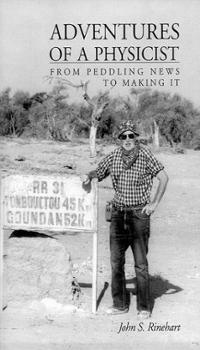Noted physicist died Friday April 9, 1999. Beloved husband of Marion; loving father to Margot and Eric and doting Grandpa to Adriane, Elizabeth and Alex.
Private cremation services have been held.
Dr. John S. Rinehart Memorial Endowment
Dr. John S. Rinehart was a longtime member of the New Mexico Tech Research Foundation. This endowment, named in his memory, is to fund a scholarship for an undergraduate majoring in physics or a similar study.
John Sargent Rinehart (b. Feb. 8, 1915; d. April 9, 1999) earned his B. S. in education and A. B. in physics, both at Truman State University in Missouri; his M.S. in physics at Caltech; and his Ph.D. in physics at the State University of Iowa.
From September 1940 through Dec. 1941, he taught college physics at Fort Hayes Kansas State College and Wayne State University. In January 1942, he moved to Washington, D.C., where he worked on developing proximity fuzes, for which he received the Presidential Certificate of Merit.
After the war, John joined physicist E.J. Workman and his research group, who at that time were studying proximity fuzes and other terminal ballistic effects on a range south of Albuquerque (in what is now the southern part of the Sandia National Labs/Kirtland AFB facility).
In Jan. 1949, Rinehart moved to the Naval Ordnance Test Station at China Lake, Calif., where he continued his work in terminal ballistics, shaped charges, formation of craters, and finally metal-explosive systems, spalling, fracturing, and ultra high-speed flight. This was perhaps his greatest contribution to physics, and with John Pearson, he published two books: Behavior of Metals under Impulsive Loads and Explosive Working of Metals.
Later in his career, in the 1950s, Rinehart worked under astronomer Fred Whipple in Cambridge, Mass., studying crater formation and meteorites. In the late 1950s and early 1960s, John taught mining engineering at the Colorado School of Mines and held a Fulbright Fellowship in Egypt. He later joined the U.S. Coast and Geodetic Survey as director of research. The organization later became NOAA, and the research arm was moved to Boulder, Colo., where John conducted studies of geysers. He retired in 1973 but continued to consult for many years.
Rinehart published over 100 scientific papers on metal-explosive systems and geysers. He also published two additional books: Stress Waves in Solids and Geysers and Geothermal Energy.
The Rinehart family has many connections with New Mexico Tech. (John married Marion Sladky in 1940.) Their son, Eric John Rinehart, got his master's in 1976 and his Ph.D. in 1979, both in geophysics. (The Rineharts also have a daughter, Margot Rinehart Swovelan.) Eric's daughter Elizabeth Rinehart graduated with a bachelor's degree in mathematics in 1999. Her two brothers, Adam and Alex, both took summer mini-courses at New Mexico Tech.
Noted physicist died Friday April 9, 1999. Beloved husband of Marion; loving father to Margot and Eric and doting Grandpa to Adriane, Elizabeth and Alex.
Private cremation services have been held.
Dr. John S. Rinehart Memorial Endowment
Dr. John S. Rinehart was a longtime member of the New Mexico Tech Research Foundation. This endowment, named in his memory, is to fund a scholarship for an undergraduate majoring in physics or a similar study.
John Sargent Rinehart (b. Feb. 8, 1915; d. April 9, 1999) earned his B. S. in education and A. B. in physics, both at Truman State University in Missouri; his M.S. in physics at Caltech; and his Ph.D. in physics at the State University of Iowa.
From September 1940 through Dec. 1941, he taught college physics at Fort Hayes Kansas State College and Wayne State University. In January 1942, he moved to Washington, D.C., where he worked on developing proximity fuzes, for which he received the Presidential Certificate of Merit.
After the war, John joined physicist E.J. Workman and his research group, who at that time were studying proximity fuzes and other terminal ballistic effects on a range south of Albuquerque (in what is now the southern part of the Sandia National Labs/Kirtland AFB facility).
In Jan. 1949, Rinehart moved to the Naval Ordnance Test Station at China Lake, Calif., where he continued his work in terminal ballistics, shaped charges, formation of craters, and finally metal-explosive systems, spalling, fracturing, and ultra high-speed flight. This was perhaps his greatest contribution to physics, and with John Pearson, he published two books: Behavior of Metals under Impulsive Loads and Explosive Working of Metals.
Later in his career, in the 1950s, Rinehart worked under astronomer Fred Whipple in Cambridge, Mass., studying crater formation and meteorites. In the late 1950s and early 1960s, John taught mining engineering at the Colorado School of Mines and held a Fulbright Fellowship in Egypt. He later joined the U.S. Coast and Geodetic Survey as director of research. The organization later became NOAA, and the research arm was moved to Boulder, Colo., where John conducted studies of geysers. He retired in 1973 but continued to consult for many years.
Rinehart published over 100 scientific papers on metal-explosive systems and geysers. He also published two additional books: Stress Waves in Solids and Geysers and Geothermal Energy.
The Rinehart family has many connections with New Mexico Tech. (John married Marion Sladky in 1940.) Their son, Eric John Rinehart, got his master's in 1976 and his Ph.D. in 1979, both in geophysics. (The Rineharts also have a daughter, Margot Rinehart Swovelan.) Eric's daughter Elizabeth Rinehart graduated with a bachelor's degree in mathematics in 1999. Her two brothers, Adam and Alex, both took summer mini-courses at New Mexico Tech.
Family Members
Sponsored by Ancestry
Advertisement
Advertisement










